实验三 类和对象_基础编程2
实验任务1
实验源代码如下:
button.hpp
1 #pragma once 2 3 #include <iostream> 4 #include <string> 5 6 class Button { 7 public: 8 Button(const std::string& label_); 9 const std::string& get_label() const; 10 void click(); 11 12 private: 13 std::string label; 14 }; 15 16 Button::Button(const std::string& label_) : label{ label_ } { 17 } 18 19 inline const std::string& Button::get_label() const { 20 return label; 21 } 22 23 inline void Button::click() { 24 std::cout << "Button '" << label << "' clicked\n"; 25 }
window.hpp
1 #pragma once 2 #include <iostream> 3 #include <vector> 4 #include <algorithm> 5 #include "button.hpp" 6 7 class Window { 8 public: 9 Window(const std::string& title_); 10 void display() const; 11 void close(); 12 void add_button(const std::string& label); 13 void click_button(const std::string& label); 14 15 private: 16 bool has_button(const std::string& label) const; 17 18 private: 19 std::string title; 20 std::vector<Button> buttons; 21 }; 22 23 Window::Window(const std::string& title_) : title{ title_ } { 24 buttons.push_back(Button("close")); 25 } 26 27 inline void Window::display() const { 28 std::string s(40, '*'); 29 std::cout << s << std::endl; 30 std::cout << "window : " << title << std::endl; 31 int cnt = 0; 32 for (const auto& button : buttons) 33 std::cout << ++cnt << ". " << button.get_label() << std::endl; 34 std::cout << s << std::endl; 35 } 36 37 inline void Window::close() { 38 std::cout << "close window '" << title << "'" << std::endl; 39 click_button("close"); 40 } 41 42 inline bool Window::has_button(const std::string& label) const { 43 for (const auto& button : buttons) 44 if (button.get_label() == label) 45 return true; 46 47 return false; 48 } 49 50 inline void Window::add_button(const std::string& label) { 51 if (has_button(label)) 52 std::cout << "button " << label << " already exists!\n"; 53 else 54 buttons.push_back(Button(label)); 55 } 56 57 inline void Window::click_button(const std::string& label) { 58 for (auto& button : buttons) 59 if (button.get_label() == label) { 60 button.click(); 61 return; 62 } 63 64 std::cout << "no button: " << label << std::endl; 65 }
task1.cpp
1 #include "window.hpp" 2 #include <iostream> 3 4 void test() { 5 Window w("Demo"); 6 w.add_button("add"); 7 w.add_button("remove"); 8 w.add_button("modify"); 9 w.add_button("add"); 10 w.display(); 11 w.close(); 12 } 13 14 int main() { 15 std::cout << "用组合类模拟简单GUI:\n"; 16 test(); 17 }
实验运行结果截图如下:
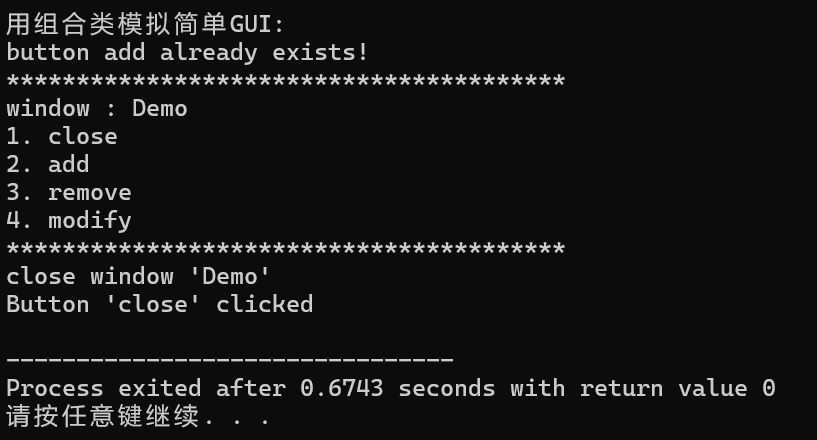
问题1:这个范例中,window和button是组合关系吗?
是组合关系,在window类中包含了button成员,在vector<button>中。
1 #include <iostream> 2 #include <vector> 3 4 void test1(); 5 void test2(); 6 void output1(const std::vector<int>& v); 7 void output2(const std::vector<int>& v); 8 void output3(const std::vector<std::vector<int>>& v); 9 10 int main() { 11 std::cout << "深复制验证1: 标准库vector<int>\n"; 12 test1(); 13 14 std::cout << "\n深复制验证2: 标准库vector<int>嵌套使用\n"; 15 test2(); 16 } 17 18 void test1() { 19 std::vector<int> v1(5, 42); 20 const std::vector<int> v2(v1); 21 22 std::cout << "**********拷贝构造后**********\n"; 23 std::cout << "v1: "; output1(v1); 24 std::cout << "v2: "; output1(v2); 25 26 v1.at(0) = -1; 27 28 std::cout << "**********修改v1[0]后**********\n"; 29 std::cout << "v1: "; output1(v1); 30 std::cout << "v2: "; output1(v2); 31 } 32 33 void test2() { 34 std::vector<std::vector<int>> v1{ {1, 2, 3}, {4, 5, 6, 7} }; 35 const std::vector<std::vector<int>> v2(v1); 36 37 std::cout << "**********拷贝构造后**********\n"; 38 std::cout << "v1: "; output3(v1); 39 std::cout << "v2: "; output3(v2); 40 41 v1.at(0).push_back(-1); 42 43 std::cout << "**********修改v1[0]后**********\n"; 44 std::cout << "v1: \n"; output3(v1); 45 std::cout << "v2: \n"; output3(v2); 46 } 47 48 void output1(const std::vector<int>& v) { 49 if (v.size() == 0) { 50 std::cout << '\n'; 51 return; 52 } 53 54 std::cout << v.at(0); 55 for (auto i = 1; i < v.size(); ++i) 56 std::cout << ", " << v.at(i); 57 std::cout << '\n'; 58 } 59 60 void output2(const std::vector<int>& v) { 61 if (v.size() == 0) { 62 std::cout << '\n'; 63 return; 64 } 65 66 auto it = v.begin(); 67 std::cout << *it; 68 69 for (it = v.begin() + 1; it != v.end(); ++it) 70 std::cout << ", " << *it; 71 std::cout << '\n'; 72 } 73 74 void output3(const std::vector<std::vector<int>>& v) { 75 if (v.size() == 0) { 76 std::cout << '\n'; 77 return; 78 } 79 80 for (auto& i : v) 81 output2(i); 82 }
实验运行结果截图如下:
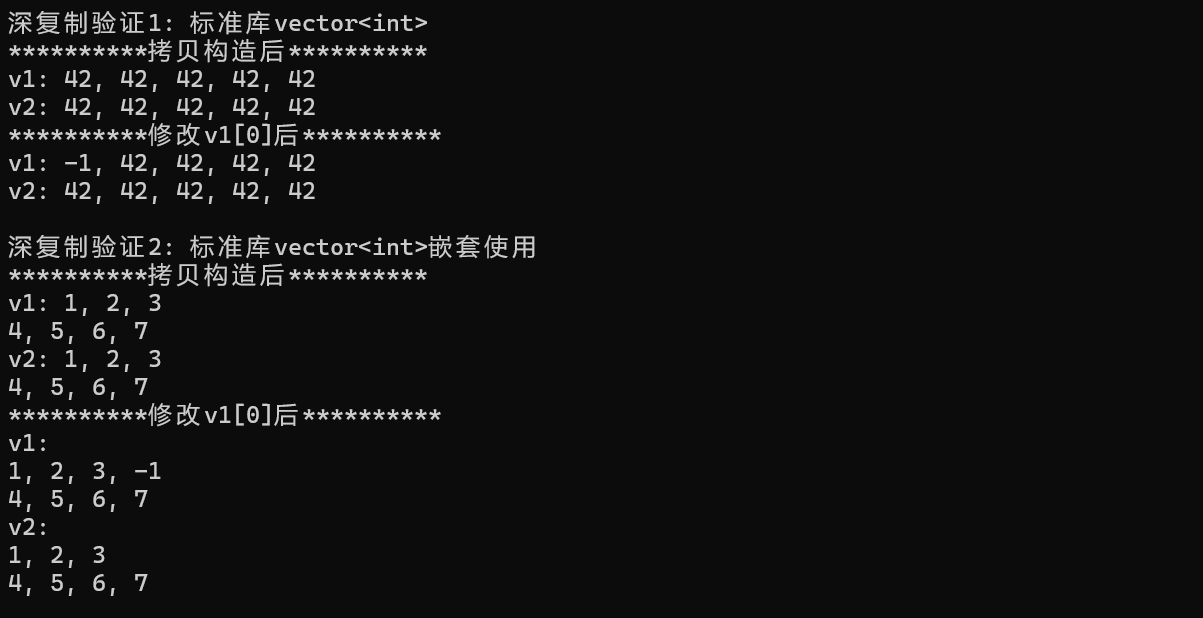

第一行是普通构造函数,传入了两个参数,前者为元素数量,后者为元素值。第二行是复制构造函数,传入v1并构造一个和v1一样的v2。v1和v2都是包含5个值为42的数据项

添加代码std::cout << v1.size() << ", " << v2.size() << ", " << v1[0].size() << std::endl;运行结果截图如下:

三者值分别为2,2,3

可以输出-1,利用r取得了嵌套vector的vector中的第一个vector,并取其最后一个元素,而-1正好添加在了此vector中的最后一个元素,故可以输出-1
1 #pragma once 2 3 #include <iostream> 4 5 6 class vectorInt{ 7 public: 8 vectorInt(); 9 vectorInt(int n_); 10 vectorInt(int n_, int value); 11 vectorInt(const vectorInt &vi); 12 ~vectorInt(); 13 14 int size() const; 15 int& at(int index); 16 const int& at(int index) const; 17 vectorInt& assign(const vectorInt &vi); 18 19 int* begin(); 20 int* end(); 21 const int* begin() const; 22 const int* end() const; 23 24 private: 25 int n; 26 int *ptr; 27 }; 28 29 vectorInt::vectorInt():n{0}, ptr{nullptr} { 30 } 31 32 vectorInt::vectorInt(int n_): n{n_}, ptr{new int[n]} { 33 } 34 35 vectorInt::vectorInt(int n_, int value): n{n_}, ptr{new int[n_]} { 36 for(auto i = 0; i < n; ++i) 37 ptr[i] = value; 38 } 39 40 vectorInt::vectorInt(const vectorInt &vi): n{vi.n}, ptr{new int[n]} { 41 for(auto i = 0; i < n; ++i) 42 ptr[i] = vi.ptr[i]; 43 } 44 45 vectorInt::~vectorInt() { 46 delete [] ptr; 47 } 48 49 int vectorInt::size() const { 50 return n; 51 } 52 53 const int& vectorInt::at(int index) const { 54 if(index < 0 || index >= n) { 55 std::cerr << "IndexError: index out of range\n"; 56 std::exit(1); 57 } 58 59 return ptr[index]; 60 } 61 62 int& vectorInt::at(int index) { 63 if(index < 0 || index >= n) { 64 std::cerr << "IndexError: index out of range\n"; 65 std::exit(1); 66 } 67 68 return ptr[index]; 69 } 70 71 vectorInt& vectorInt::assign(const vectorInt &vi) { 72 if(this == &vi) 73 return *this; 74 75 int *ptr_tmp; 76 ptr_tmp = new int[vi.n]; 77 for(int i = 0; i < vi.n; ++i) 78 ptr_tmp[i] = vi.ptr[i]; 79 80 delete[] ptr; 81 n = vi.n; 82 ptr = ptr_tmp; 83 return *this; 84 } 85 86 int* vectorInt::begin() { 87 return ptr; 88 } 89 90 int* vectorInt::end() { 91 return ptr+n; 92 } 93 94 const int* vectorInt::begin() const { 95 return ptr; 96 } 97 98 const int* vectorInt::end() const { 99 return ptr+n; 100 }
task3.cpp
1 #include "vectorInt.hpp" 2 #include <iostream> 3 4 void test1(); 5 void test2(); 6 void output1(const vectorInt &vi); 7 void output2(const vectorInt &vi); 8 9 int main() { 10 std::cout << "测试1: \n"; 11 test1(); 12 13 std::cout << "\n测试2: \n"; 14 test2(); 15 } 16 17 void test1() { 18 int n; 19 std::cout << "Enter n: "; 20 std::cin >> n; 21 22 vectorInt x1(n); 23 for(auto i = 0; i < n; ++i) 24 x1.at(i) = (i+1)*10; 25 std::cout << "x1: "; output1(x1); 26 27 vectorInt x2(n, 42); 28 vectorInt x3(x2); 29 x2.at(0) = -1; 30 std::cout << "x2: "; output1(x2); 31 std::cout << "x3: "; output1(x3); 32 } 33 34 void test2() { 35 const vectorInt x(5, 42); 36 vectorInt y; 37 38 y.assign(x); 39 40 std::cout << "x: "; output2(x); 41 std::cout << "y: "; output2(y); 42 } 43 44 void output1(const vectorInt &vi) { 45 if(vi.size() == 0) { 46 std::cout << '\n'; 47 return; 48 } 49 50 std::cout << vi.at(0); 51 for(auto i = 1; i < vi.size(); ++i) 52 std::cout << ", " << vi.at(i); 53 std::cout << '\n'; 54 } 55 56 void output2(const vectorInt &vi) { 57 if(vi.size() == 0) { 58 std::cout << '\n'; 59 return; 60 } 61 62 auto it = vi.begin(); 63 std::cout << *it; 64 65 for(it = vi.begin()+1; it != vi.end(); ++it) 66 std::cout << ", " << *it; 67 std::cout << '\n'; 68 }
实验运行结果截图如图所示:
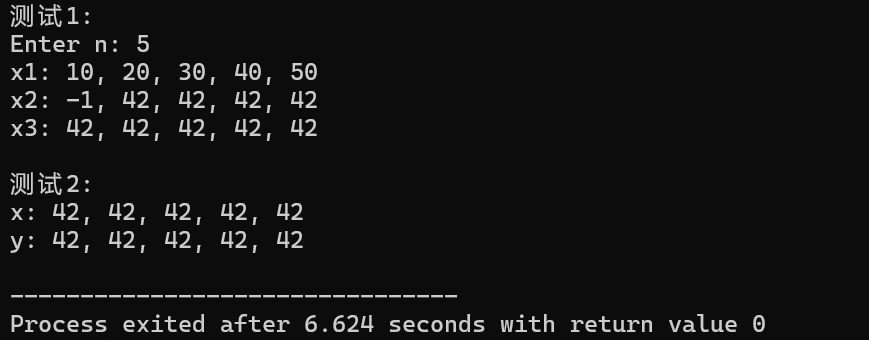
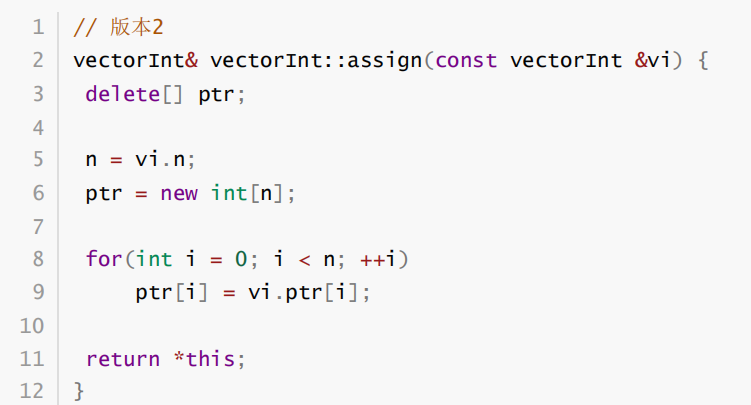
1.原代码一开始会进行判等操作,只要调用assign的对象和传入的vi是同一个对象,下面就省去了复制操作的开销,而版本2此代码没有考虑到这点
2.版本2代码一开始就将ptr内存回收,若调用assign的对象和传入的vi是同一个对象,回收ptr后vi.ptr也被释放,后续运行会出错
3.原代码使用ptr_tmp,首先将vi信息复制给ptr_tmp,无错误后再将ptr_tmp换为ptr,保证了数据的正确性,避免获得错误数据


it1调用非const类型的begin()函数,it2调用const类型的begin()函数
非const类型的begin()函数适用于容器内部元素均为非const类型的容器,而const类型的适用于容器内部元素均为const类型的容器
(2)标准库迭代器本质上是指针的封装。 vectorInt 直接返回原始指针作为迭代器,这种设计让你对迭代器有什么新的理解?
迭代器的本质就是指针,通过指针去完成容器内部元素的遍历、访问等操作
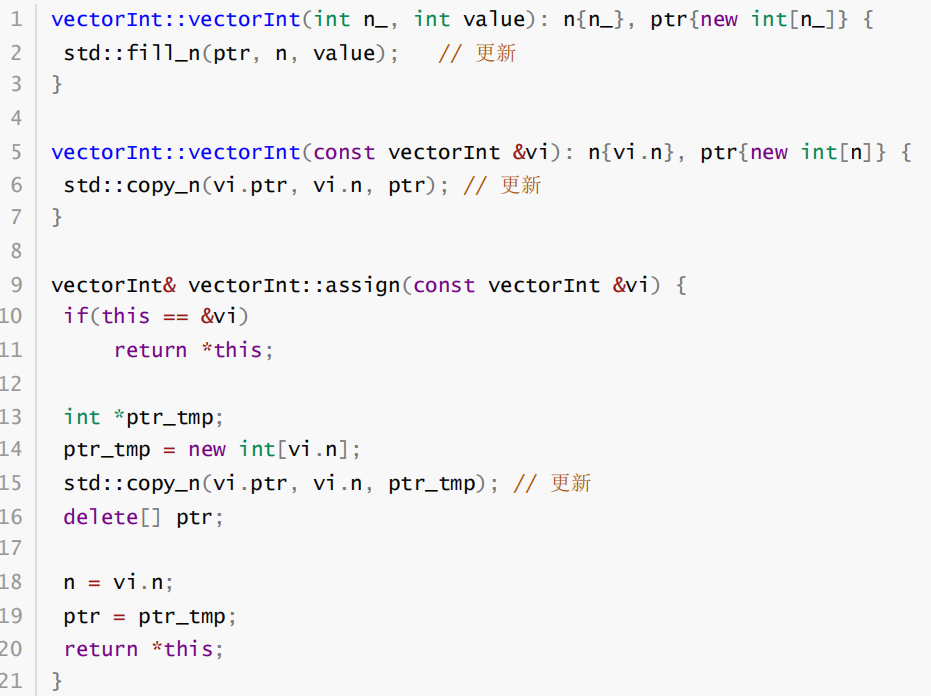
换成这三种写法可以
第一行:以ptr指向位置为起点,将此后的n个元素赋值为value
第二行:将以vi.ptr为起点的vi.n个元素复制到以ptr为起点的位置
第三行:将以vi.ptr为起点的vi.n个元素复制到以ptr_tmp为起点的位置
实验任务4
程序源代码如下:
matrix.hpp
1 #pragma once 2 3 #include <iostream> 4 #include <algorithm> 5 #include <cstdlib> 6 7 class Matrix { 8 public: 9 Matrix(int rows_, int cols_, double value = 0); 10 Matrix(int rows_, double value = 0); 11 Matrix(const Matrix& x); 12 ~Matrix(); 13 14 void set(const double* pvalue, int size); 15 void clear(); 16 17 const double& at(int i, int j) const; 18 double& at(int i, int j); 19 20 int rows() const; 21 int cols() const; 22 23 void print() const; 24 25 private: 26 int n_rows; 27 int n_cols; 28 double* ptr; 29 }; 30 31 Matrix::Matrix(int rows_, int cols_, double value) :n_rows(rows_), n_cols(cols_), ptr(new double[rows_* cols_]) { 32 for (int i = 0; i < n_rows*n_cols; i++) { 33 ptr[i] = value; 34 } 35 } 36 37 Matrix::Matrix(int rows_, double value) :n_rows(rows_), n_cols(rows_), ptr(new double[rows_* rows_]) { 38 for (int i = 0; i < n_rows * n_cols; i++) { 39 ptr[i] = value; 40 } 41 } 42 43 Matrix::Matrix(const Matrix& x):n_rows(x.n_rows), n_cols(x.n_cols), ptr(new double[x.n_rows * x.n_cols]){ 44 for (int i = 0; i < n_rows * n_cols; i++) { 45 ptr[i] = x.ptr[i]; 46 } 47 } 48 49 Matrix::~Matrix() { delete[]ptr; } 50 51 void Matrix::set(const double* pvalue, int size) { 52 if (size != n_rows * n_cols) { 53 std::cout << "size ERROR" << std::endl; 54 return; 55 } 56 else { 57 for (int i = 0; i < size; i++) { 58 ptr[i] = pvalue[i]; 59 } 60 } 61 } 62 63 void Matrix::clear() { 64 for (int i = 0; i < n_rows * n_cols; i++) { 65 ptr[i] = 0; 66 } 67 } 68 69 const double& Matrix::at(int i, int j) const { 70 if (i < 0 || j < 0 || i >= n_rows || j >= n_cols) { 71 std::cout << "at ERROR" << std::endl; 72 } 73 else { return ptr[i * n_cols + j]; } 74 } 75 76 double& Matrix::at(int i, int j) { return const_cast<double&>(static_cast<const Matrix*>(this)->at(i, j)); } 77 78 int Matrix::rows() const { return n_rows; } 79 80 int Matrix::cols() const { return n_cols; } 81 82 void Matrix::print() const { 83 for (int i = 0; i < n_rows; ++i) { 84 for (int j = 0; j < n_cols; ++j) { 85 std::cout << ptr[i * n_cols + j]; 86 if(j!=n_cols-1)std::cout << ", "; 87 } 88 std::cout << std::endl; 89 } 90 }
task4.cpp
1 #include <iostream> 2 #include <cstdlib> 3 #include "matrix.hpp" 4 5 void test1(); 6 void test2(); 7 void output(const Matrix& m, int row_index); 8 9 int main() { 10 std::cout << "测试1: \n"; 11 test1(); 12 13 std::cout << "\n测试2: \n"; 14 test2(); 15 } 16 17 void test1() { 18 double x[1000] = { 1, 2, 3, 4, 5, 6, 7, 8, 9, 10 }; 19 20 int n, m; 21 std::cout << "Enter n and m: "; 22 std::cin >> n >> m; 23 24 Matrix m1(n, m); 25 m1.set(x, n * m); 26 27 Matrix m2(m, n); 28 m2.set(x, m * n); 29 30 Matrix m3(n); 31 m3.set(x, n * n); 32 33 std::cout << "矩阵对象m1: \n"; m1.print(); 34 std::cout << "矩阵对象m2: \n"; m2.print(); 35 std::cout << "矩阵对象m3: \n"; m3.print(); 36 } 37 38 void test2() { 39 Matrix m1(2, 3, -1); 40 const Matrix m2(m1); 41 42 std::cout << "矩阵对象m1: \n"; m1.print(); 43 std::cout << "矩阵对象m2: \n"; m2.print(); 44 45 m1.clear(); 46 m1.at(0, 0) = 1; 47 48 std::cout << "m1更新后: \n"; 49 std::cout << "矩阵对象m1第0行 "; output(m1, 0); 50 std::cout << "矩阵对象m2第0行: "; output(m2, 0); 51 } 52 53 void output(const Matrix& m, int row_index) { 54 if (row_index < 0 || row_index >= m.rows()) { 55 std::cerr << "IndexError: row index out of range\n"; 56 exit(1); 57 } 58 59 std::cout << m.at(row_index, 0); 60 for (int j = 1; j < m.cols(); ++j) 61 std::cout << ", " << m.at(row_index, j); 62 std::cout << '\n'; 63 }
程序运行结果截图如下:
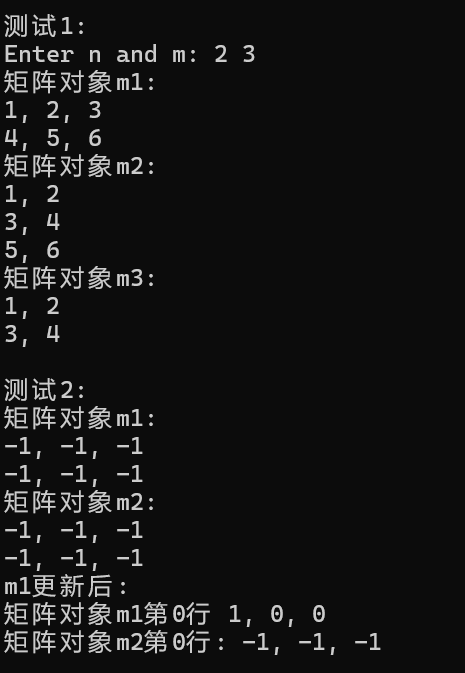
实验任务5
实验源代码如下:
contact.hpp
1 #pragma once 2 3 #include <iostream> 4 #include <string> 5 6 class Contact { 7 public: 8 Contact(const std::string& name_, const std::string& phone_); 9 10 const std::string& get_name() const; 11 const std::string& get_phone() const; 12 void display() const; 13 14 private: 15 std::string name; 16 std::string phone; 17 }; 18 19 Contact::Contact(const std::string& name_, const std::string& phone_) :name{ name_ }, phone{ phone_ } { 20 } 21 22 const std::string& Contact::get_name() const { 23 return name; 24 } 25 26 const std::string& Contact::get_phone() const { 27 return phone; 28 } 29 30 void Contact::display() const { 31 std::cout << name << ", " << phone; 32 }
contactBook.hpp
1 # pragma once 2 3 #include <iostream> 4 #include <string> 5 #include <vector> 6 #include <algorithm> 7 #include "contact.hpp" 8 9 class ContactBook { 10 public: 11 void add(const std::string& name, const std::string& phone); 12 void remove(const std::string& name); 13 void find(const std::string& name) const; 14 void display() const; 15 size_t size() const; 16 17 private: 18 int index(const std::string& name) const; 19 void sort(); 20 21 private: 22 std::vector<Contact> contacts; 23 }; 24 25 void ContactBook::add(const std::string& name, const std::string& phone) { 26 if (index(name) == -1) { 27 contacts.push_back(Contact(name, phone)); 28 std::cout << name << " add successfully.\n"; 29 sort(); 30 return; 31 } 32 33 std::cout << name << " already exists. fail to add!\n"; 34 } 35 36 void ContactBook::remove(const std::string& name) { 37 int i = index(name); 38 39 if (i == -1) { 40 std::cout << name << " not found, fail to remove!\n"; 41 return; 42 } 43 44 contacts.erase(contacts.begin() + i); 45 std::cout << name << " remove successfully.\n"; 46 } 47 48 void ContactBook::find(const std::string& name) const { 49 int i = index(name); 50 51 if (i == -1) { 52 std::cout << name << " not found!\n"; 53 return; 54 } 55 56 contacts[i].display(); 57 std::cout << '\n'; 58 } 59 60 void ContactBook::display() const { 61 for (auto& c : contacts) { 62 c.display(); 63 std::cout << '\n'; 64 } 65 } 66 67 size_t ContactBook::size() const { 68 return contacts.size(); 69 } 70 71 int ContactBook::index(const std::string& name) const{ 72 int count = 0; 73 for (auto& i : contacts) { 74 if (i.get_name()==name) { 75 return count; 76 } 77 count++; 78 } 79 return -1; 80 } 81 82 bool compare(Contact& a, Contact& b) { 83 return a.get_name() < b.get_name(); 84 } 85 86 void ContactBook::sort() { 87 std::sort(contacts.begin(), contacts.end(), compare); 88 }
task5.cpp
1 #include "contactBook.hpp" 2 3 void test() { 4 ContactBook contactbook; 5 6 std::cout << "1. add contacts\n"; 7 contactbook.add("Bob", "18199357253"); 8 contactbook.add("Alice", "17300886371"); 9 contactbook.add("Linda", "18184538072"); 10 contactbook.add("Alice", "17300886371"); 11 12 std::cout << "\n2. display contacts\n"; 13 std::cout << "There are " << contactbook.size() << " contacts.\n"; 14 contactbook.display(); 15 16 std::cout << "\n3. find contacts\n"; 17 contactbook.find("Bob"); 18 contactbook.find("David"); 19 20 std::cout << "\n4. remove contact\n"; 21 contactbook.remove("Bob"); 22 contactbook.remove("David"); 23 } 24 25 int main() { 26 test(); 27 }
实验结果截图如下:

实验总结
通过此次实验,我最大的收获是最小化接口的应用,通过对数据类型的转换,可以将两功能相近但返回值类型不同的函数通过此方式相互调用可以使接口最小化,避免冗余代码的书写




 浙公网安备 33010602011771号
浙公网安备 33010602011771号